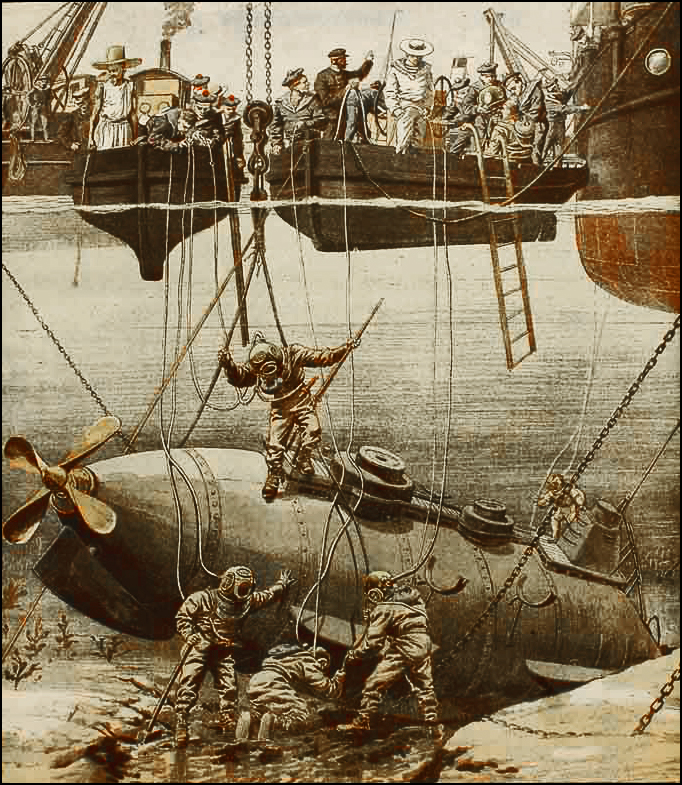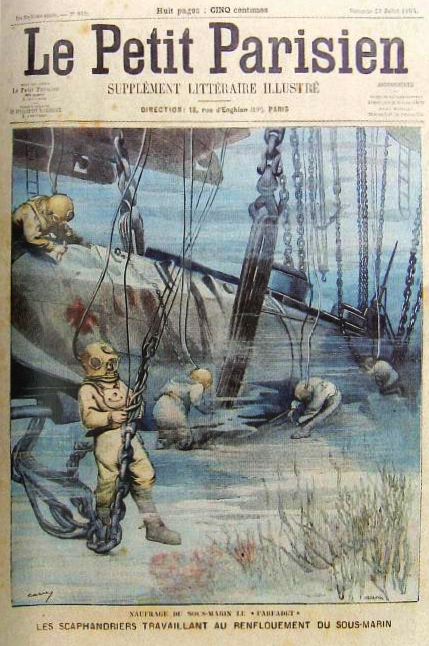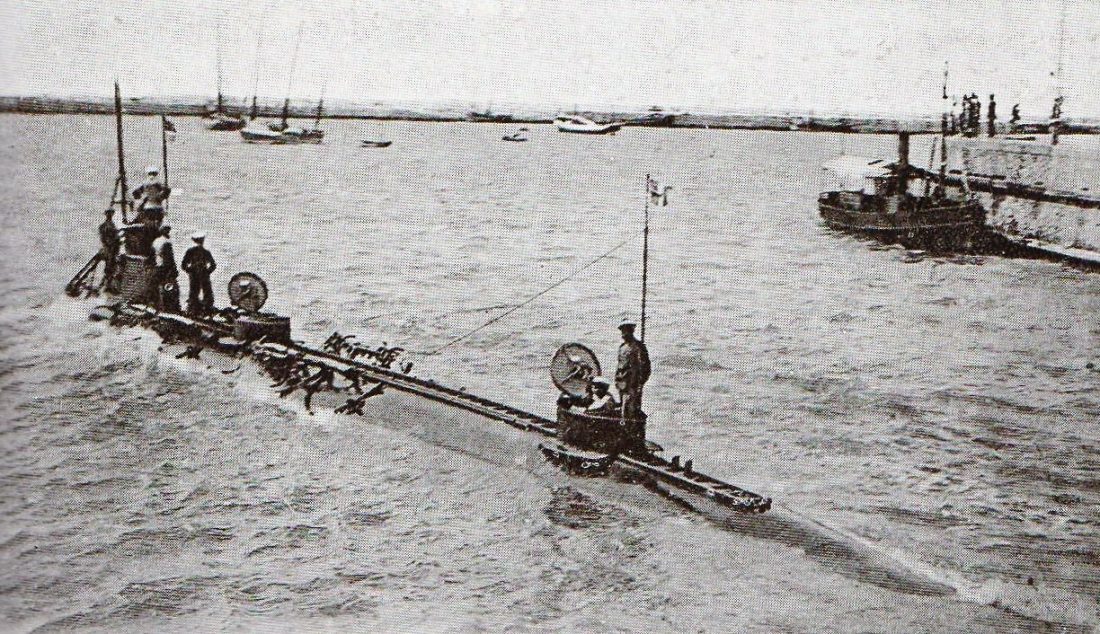France’s Farfadet Submarine Disaster 1905
Courage of the highest order was demanded of the officers and men of the navies that first employed submarines in the early twentieth centuries. Designs were still experimental and operating experience limited, so that every dive was an adventure. Accidents were frequent – and usually fatal when they did occur – and progress was achieved by learning very hard lessons.
The French navy was one of the first to commit to large-scale submarine construction. It looked to the new weapon, as it had looked to torpedo boats two decades before, as a cheap method of compensating for relative weakness in battleship numbers by comparison with potential rivals. At this stage submarines were primarily seen as suited to coastal and port-defence and the second –and so-far largest – design class, the four Farfadet units, launched between 1901 and 1903 were intended for this purpose.
 The Farfadet in service
The Farfadet in service
135-ft. long and of 185/ 202 tons (surface/submerged), units of the Farfadet class were propelled by a single electric motor driving a variable-pitch propeller. The latter was an innovative item that dispensed with the need to provide reversing capability for the motor. Range, determined by the batteries that had to be charged at the operating base, was limited to 115 miles surfaced and 28 submerged, and the maximum speeds attainable were 6.1 knots on the surface and 4.3 knots when submerged. Small as they were, these units packed a potentially powerful punch – four 18-inch torpedoes carried on external drop collars. The potency was proved when one unit of the class, the Korrigan, succeeded in hitting the cruiser Tempete with a practice torpedo while remaining unobserved – possibly the first time a target had been hit by a torpedo launched by a submarine. This considerable feat demanded the Korrigan and her sixteen-man crew remaining submerged for some twelve hours, somewhat of a record.

A contemporary artist’s impression of salvage operations. Shallowness of water is exaggerated
Both Korrigan and Farfadet were towed from La Rochelle, on the French Atlantic coast to the naval base at Bizerte, in Tunisia, in 1904 to provide port-defence. It was here that disaster was to overcome the Farfadet on July 6th of the following year when the vessel was undertaking diving exercises some 500 yards from the arsenal. Commander Cyprien Ratier ordered water to be admitted to the ballast tanks and the craft began to settle very quickly – too quickly, for the hatch was not closed properly. (It will be seen from the photographs that the hatches were a point of vulnerability as they were very close to the waterline when surfaced and there was no tower as such). Ratier, his mate and the quartermaster struggled unsuccessfully to close the hatch. Large volumes of water where now cascading into the boat’s interior and Ratier and his two assistants were blasted out through the hatch by the escaping air. The Farfadet sank, head-foremost, and buried her bows in the mud. Fourteen men had gone down with her.

Immense public interest
in the salvage
The stricken craft was lying in approximately thirty feet of water and some salvage equipment was immediately available at the base. There were obviously still men alive inside, for they were hammering on the hull. By the following morning divers had managed to get four steel hawsers passed around the hull and a floating crane managed to lift it in the early afternoon so as to lash it to a pontoon. Sufficient of the hull had been exposed for air-valves to be accessed and air passed in to the survivors. It was now attempted to move the craft into shallow water, so as to ground her. The process was a slow one and in the early hours of the following morning the hawsers parted and the Farfadet dropped again. Further efforts failed to lift her before the victims trapped inside died. No further sounds were heard after July 8th, two days after the disaster. (One notices dreadful similarities to the HMS Thetis disaster in Liverpool Bay in 1939, when the stern of the sunken submarine had been raised above the surface).
Salvage efforts continued, a floating dock being used to lift the Farfadet – once again, the role of divers would have been crucial in passing hawsers under, and around, the hull. On July 9th, the Minister of Marine, Gaston Thomson, arrived from Paris to observe operations. On July 15th, the floating dock and the submarine suspended underneath were towed into a dry dock. The floating dock lowered the Farfadet, was then removed, and the dry dock was pumped out to expose the vessel.
 The Farfadet – recovered and lying on her side in the dry dock.
The Farfadet – recovered and lying on her side in the dry dock.

Repatriating the bodies
The distressing duty of retrieving the bodies was allocated to the crew of the sister submarine Korrigan. Four bodies were discovered in the bow compartment, and two in the centre, all probably killed during the initial inrush of water. Eight men had however managed to seal themselves in the compartment aft. These men – who had been beating for hours on the hull plating – had died dreadfully as seawater had reached the sulphuric acid of the batteries, thereby releasing poisonous chlorine gas. It appeared that the last of the crew had died after being trapped for 32 hours.
The long-drawn out agony of the Farfadet had kept France in horror-stricken fascination, the more so since submarines were a new concept, poorly understood by the general public. There was a massive outpouring of national grief and an imposing funeral service was held in Bizerte and the coffins returned to France thereafter for final burial. The salvaged submarine was towed across the Mediterranean to the naval base at Toulon, was reconditioned, and taken back into service. Cyprien Ratier continued as her commander for another two years.
 The Lutin – Farfadet’s sister and doomed to follow her in a year
The Lutin – Farfadet’s sister and doomed to follow her in a year
The Farfadet was not the only one of her class to meet disaster. Her sister, the Lutin, was to sink, also near Bizerte, in October 1906. On this occasion structural failure of the hull occurred under external pressure. An expensive lesson was learned about design and an entire crew was lost. She too was salvaged. Already outmoded by the time of these disasters, and having served their purpose in introducing naval personnel to the science of submarine operation, all members of the Farfadet class were taken from service in the following years, to be replaced by more sophisticated and more reliable designs.
The Farfadet was not to be the last peacetime submarine disaster. They have continued up to our own time.
Britannia’s Shark
This volume of the Dawlish Chronicles series of historical naval novels centres on the development – and role – of a prototype submarine. Based on actual events and personalities in the early 1880s, Britannia’s Shark paints a vivid picture of the skills and courage – bordering on madness – which was needed to operate such craft. Click here or on image below for more details.
Below are the nine Dawlish Chronicles novels published to date, shown in chronological order. All can be read as “stand-alones”. Click on the banner for more information or on the “BOOKS” tab above. All are available in Paperback or Kindle format and can read at no extra charge by Kindle Unlimited or Kindle Prime Subscribers.
Six free short-stories are available for download to your Kindle. Access them by registering for the Dawlish Chronicles mailing list – just click on the banner below. You’ll be kept updated on new books and will receive other free stories at intervals.




